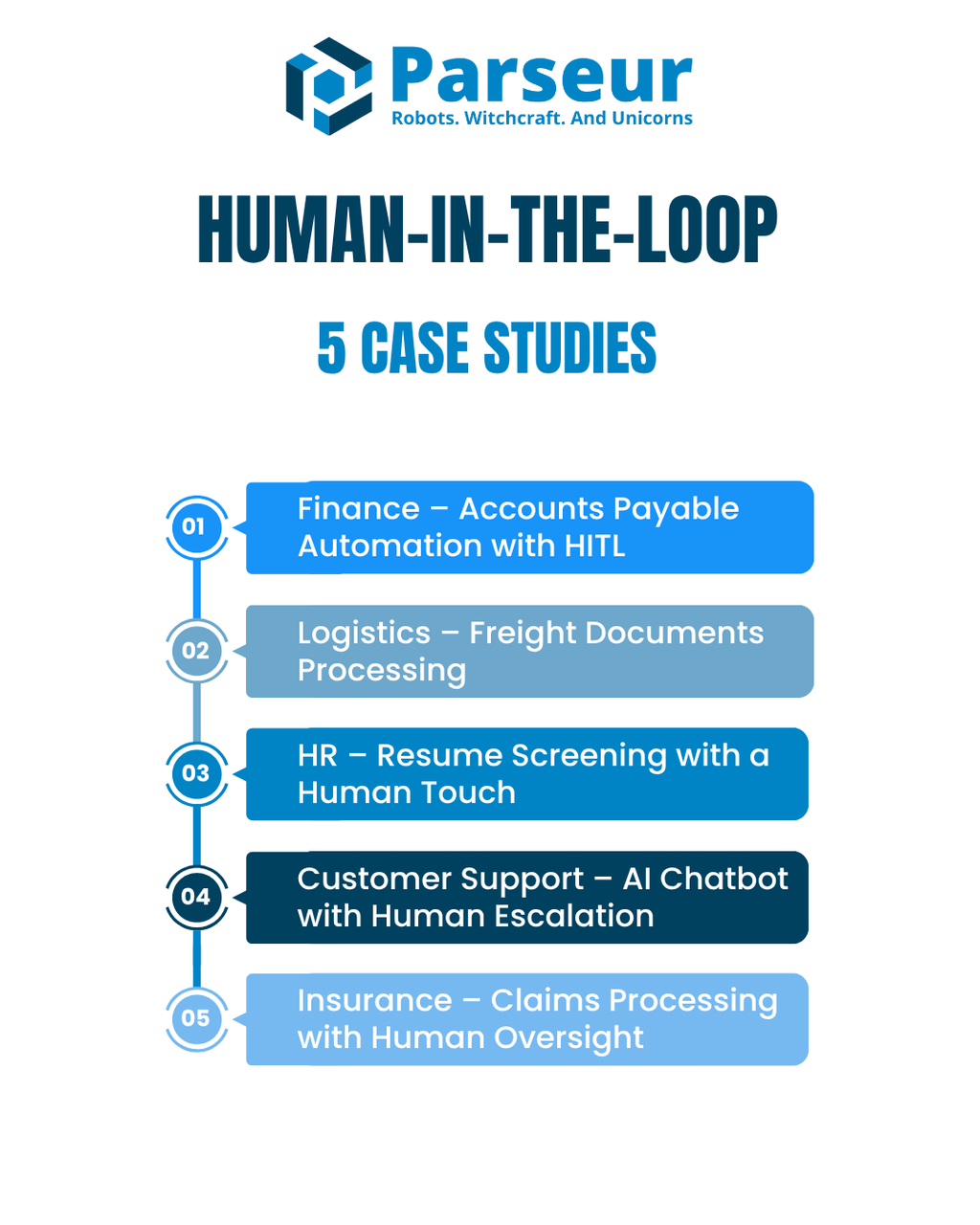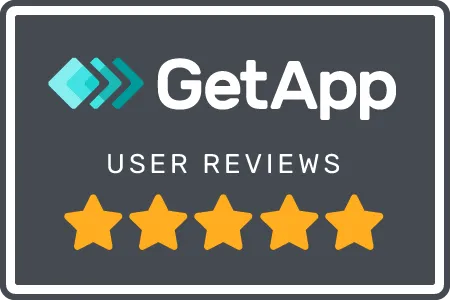Key Takeaways
- HITL increased accuracy to 99.9% and increased processing by up to 5x.
- Companies saved thousands annually and improved compliance with HITL.
- AI-human collaboration led to better hiring and customer support outcomes.
- HITL boosted productivity by letting humans focus on complex tasks.
- Blending AI with human oversight gave companies a clear competitive edge.
Real-World Case Studies of HITL AI Implementation
While the Human-in-the-Loop (HITL) concept is often discussed in theory, its real-world impact is best understood through action. Across industries, HITL workflows are delivering measurable benefits: increased accuracy, faster processing, and reduced costs. By adding human oversight to AI-driven automation, organizations avoid costly mistakes and ensure critical decisions are made with speed and judgment.
According to B2BDaily, integrating human oversight into AI workflows boosts decision-making accuracy by 31% on average while cutting false positives by 67% in high-stakes sectors like healthcare, finance, and public safety.
Learn more in our Human-in-the-Loop AI: Definition, Benefits & 2026 Guide.
A study from Marketing Scoop found that human validation reduced classification errors by up to 85% across multiple datasets.
This article explores five industry case studies showing HITL in action, each highlighting real-world ROI through before-and-after comparisons.

Case Study 1: Finance - Automating Accounts Payable
Tipalti reported that ImaginAb previously relied on manual invoice processing for accounts payable. Finance staff spent considerable time entering invoice data, chasing approvals, and reconciling payments, which was especially challenging for multi-country invoices and payments in various currencies.
This process was time-consuming and error-prone, requiring frequent overtime to meet deadlines. Due to the manual nature of the work, the risk of overpayments, audit deficiencies, and late payments was high.
ImaginAb implemented Tipalti’s AP automation platform, which incorporates HITL by automating routine data capture and processing while routing exceptions or complex cases to human staff for review and approval. The system is integrated with Sage Intacct, enhanced workflows, and manages payments in over 120 currencies across 196 countries.
Implementing HITL invoice automation eliminated approximately 1,750 hours of manual accounts payable workload annually. Despite business growth, the company avoided the need for additional headcount. It also accelerated the monthly financial close process, improving accuracy and control over multi-currency payments.
“What we found was that the accounts payable was the biggest time-consuming piece in our department that needed to be tackled first.” — Jill Durkin, ImaginAb
Case Study 2: Logistics – Freight Documents Processing
A leading North American Less-than-Truckload (LTL) carrier faced challenges with the manual processing of freight documents such as Bills of Lading, which caused delays, errors, and inefficiencies. The airline implemented WNS Malkom, an AI and machine learning-powered platform that automates end-to-end shipment document processing while incorporating HITL for exception handling and validation.
After implementing HITL automation, the carrier achieved 99% data accuracy, a 50% reduction in processing costs, and significantly faster document handling, enabling more timely deliveries. The automation also improved real-time shipment visibility and reduced invoice disputes, improving operations and customer satisfaction.
Case Study 3: HR – Resume Screening With A Human Touch
According to AI Recruiter Lab, Unilever is a global leader in using AI for HR recruitment, particularly for initial resume and application screening. While Unilever’s process goes beyond traditional resume screening, incorporating game-based assessments and video interviews, their approach exemplifies the integration of AI automation with human judgment for fair and efficient hiring. They transformed their recruitment process by implementing AI-powered resume and application screening, using platforms like Pymetrics and HireVue to assess automatically and shortlist candidates at scale.
The AI system handled the initial filtering and analysis, while human recruiters conducted final evaluations and interviews. This hybrid approach led to a 75% reduction in time-to-hire, saved over 50,000 hours of interview time annually, and generated over £1 million in annual savings.
Case Study 4: Customer Support – AI Chatbot With Human Escalation
According to Zendesk’s study, Motel Rocks, a growing fashion brand, implemented an Advanced AI chatbot to handle routine customer inquiries and enable self-service. The AI chatbot deflected 43% of support tickets and reduced overall ticket volume by 50% through self-service options. The system incorporated human escalation for complex or sensitive issues, allowing customer service agents to focus on customers needing personalized attention. This hybrid approach also improved customer satisfaction by 9.44%, as the AI sensed customer mood and prioritized support accordingly.
By combining AI efficiency with human empathy, Motel Rocks enhanced both operational efficiency and customer experience
Case Study 5: Insurance – Claims Processing With Human Oversight
EY mentioned that a leading Nordic insurance company partnered with EY to modernize its claims processing by implementing an AI-powered solution that automates the extraction and categorization of unstructured claims data, such as medical reports and invoices, while incorporating human oversight for complex cases. Before implementation, claims processing was slow and manual, causing delays and inefficiencies. After deploying the AI-human hybrid system, the insurer achieved near real-time claims processing, with 70% of documents correctly extracted and interpreted automatically, significantly accelerating decision-making.
This allowed claims agents to focus on personalized customer interactions, improving customer satisfaction and operational efficiency. The system’s design ensured transparency and control by involving humans in reviewing AI outputs, avoiding black-box automation, and building trust in the technology.
Key ROI Benchmarks & Learnings
The following case studies demonstrate how Human-in-the-Loop (HITL) solutions deliver measurable impact across multiple industries. From finance to logistics, HITL has proven to significantly improve efficiency, accuracy, and cost-effectiveness in real-world applications.
- Finance (ImaginAb): Eliminated 1,750 hours of manual AP work annually and avoided additional headcount despite growth. Accelerated financial close and improved accuracy across multi-currency payments.
- Logistics (LTL Carrier): Achieved 99% data accuracy, cut processing costs by 50%, and improved shipment visibility and delivery timelines.
- HR (Unilever): Reduced time-to-hire by 75%, saved over 50,000 hours of interview time, and generated £1 million in annual savings by integrating AI screening with human evaluation.
- Customer Support (Motel Rocks): Deflected 43% of tickets using an AI chatbot while maintaining human escalation for complex queries, leading to a 9.44% increase in customer satisfaction.
- Insurance (Nordic Insurer): Achieved near real-time claims processing, with 70% of documents accurately handled by AI and human agents focused on complex and high-touch interactions.
Common learnings:
- HITL enables faster, more accurate decisions by combining AI speed with human judgment.
- Businesses benefit from reduced costs, higher customer satisfaction, and better compliance outcomes.
- Rather than replacing jobs, HITL empowers teams to focus on high-value, strategic work.
- Productivity gains vary across industries but can range from 30% to 75% depending on process complexity and volume.
These results show that HITL is more than a trend. It is a proven strategy for driving ROI, scaling operations, and maintaining quality.
How Parseur Supports Human-in-the-Loop Workflows
At Parseur, we understand that not every document or data workflow can be fully automated. That’s why our platform is built to integrate seamlessly into Human-in-the-Loop (HITL) environments.
With powerful integrations like Zapier, Make, and Power Automate, you can:
- Automatically flag and route low-confidence data for human review
- Trigger manual approval workflows for high-value documents
- Build exception handling logic that balances automation with oversight
- Feed reviewed data back into the loop to improve future parsing accuracy
Conclusion
As these case studies show, Human-in-the-Loop AI is not just a concept; it's a proven strategy that bridges the gap between automation and accountability. By integrating human judgment into AI workflows, businesses across finance, logistics, HR, customer support, and insurance achieve higher accuracy, faster processing times, and significant cost reductions. More importantly, they are building resilient, transparent, and adaptable systems to real-world complexity.
Instead of replacing human workers, HITL enhances their roles by freeing teams from repetitive tasks and allowing them to focus on decisions that require critical thinking and empathy. As AI adoption accelerates, HITL will continue to play a vital role in ensuring operational excellence and ethical oversight.
Last updated on




